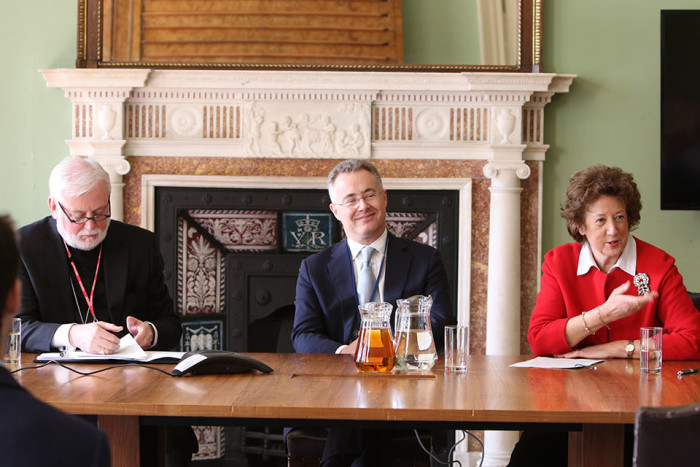10th March 2016
Archbishop Gallagher in the UK


Last week I accompanied the Holy See Secretary for Relations with States, Archbishop Paul Gallagher, on a visit to the United Kingdom. He came at the invitation of the British government, so inevitably much of his time was taken up in official meetings with a wide range of government ministers. He visited five different Departments of State – the Foreign Office, the Northern Ireland Office, the Department for International Development, the Department for Energy and Climate Change, and the Home Office – which gives a good idea of the breadth of our bilateral engagement from human trafficking to sustainable development, human rights to the latest geo-political events in Latin America, Ukraine and the Middle East. He brought many of these international threads together in a speech at the Royal United Services Institute on Holy See ‘foreign policy’.
It was not all government. Archbishop Gallagher spent a lot of time in Parliament, where he was a guest of the All Party Parliamentary Group on the Holy See, and had the chance to bring himself up to date on the latest parliamentary debates and concerns (dominated, inevitably, by the European question). He also met Baroness Scotland, the next Secretary-General of the Commonwealth, to explore how the global Commonwealth and Holy See networks, which share so much in common, might work more productively together. And he spent time with churchmen – including the Archbishop of Canterbury, the Cardinal Archbishop of Westminster, and the Archbishop of Glasgow – to look at ways in which the Holy See, Anglican and domestic Catholic networks cooperate together.
What struck me during the visit was just how many points of contact and overlap there are between Britain and the Holy See. Archbishop Gallagher was right to stress the capacity limitations of his small team in the Vatican. I could say the same about my small embassy! But so much is already happening and the visit pointed the way to more possibilities – working together to tackle sexual violence in conflict in Africa, ways in which we might cooperate in preparing for the World Humanitarian Summit in Turkey in May, the role of British and Holy See international networks in delivering on the ground the results from the Paris Climate Change Summit, or a shared endeavour to abolish the death penalty worldwide. Our bilateral agenda remains very full.
All that said, my favourite appointment of the week was the very last. The Vatican Library has loaned a number of Botticelli drawings on the subject of Dante’s Divine comedy to the Victoria and Albert Museum for its current exhibition, ‘Botticelli Reimagined’. The V&A was keen to thank Archbishop Gallagher for the support, and it was wonderful to see the drawings in situ at the culmination of the exhibition. Much of our diplomacy, including with the Holy See, is hard-edged. But this was an example of another form of bilateral exchange, just as influential and significant (and, whisper it quietly, a lot more fun).